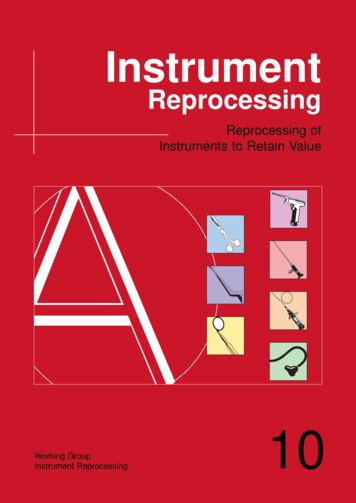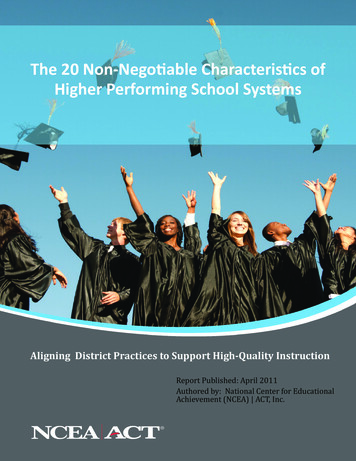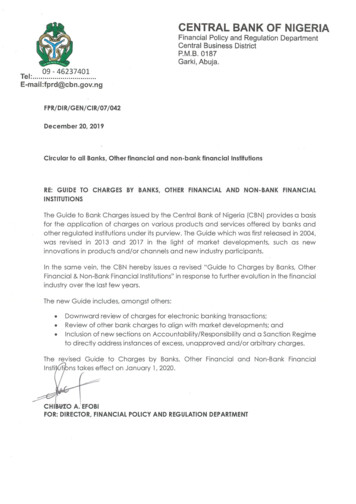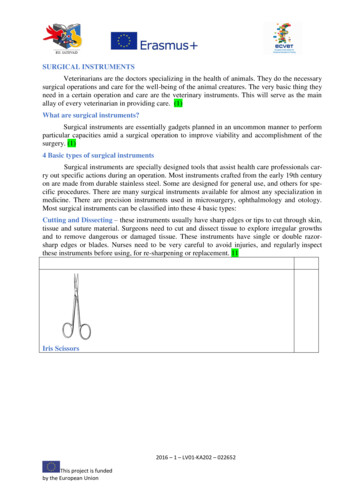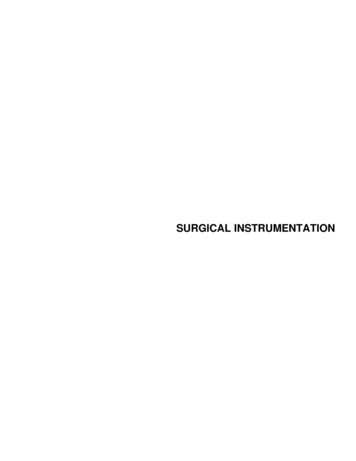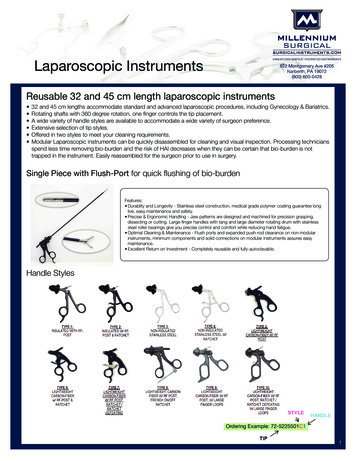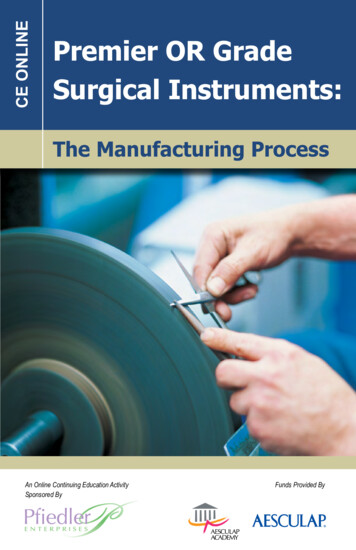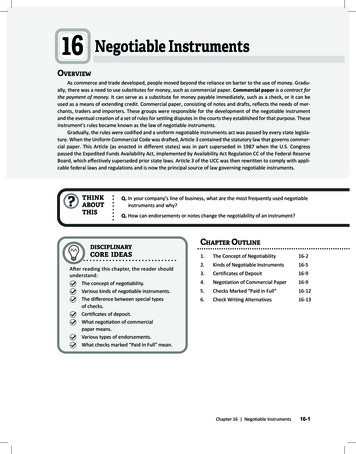
Transcription
16Negotiable InstrumentsOverviewAs commerce and trade developed, people moved beyond the reliance on barter to the use of money. Gradually, there was a need to use substitutes for money, such as commercial paper. Commercial paper is a contract forthe payment of money. It can serve as a substitute for money payable immediately, such as a check, or it can beused as a means of extending credit. Commercial paper, consisting of notes and drafts, reflects the needs of merchants, traders and importers. These groups were responsible for the development of the negotiable instrumentand the eventual creation of a set of rules for settling disputes in the courts they established for that purpose. Theseinstrument’s rules became known as the law of negotiable instruments.Gradually, the rules were codified and a uniform negotiable instruments act was passed by every state legislature. When the Uniform Commercial Code was drafted, Article 3 contained the statutory law that governs commercial paper. This Article (as enacted in different states) was in part superseded in 1987 when the U.S. Congresspassed the Expedited Funds Availability Act, implemented by Availability Act Regulation CC of the Federal ReserveBoard, which effectively superseded prior state laws. Article 3 of the UCC was then rewritten to comply with applicable federal laws and regulations and is now the principal source of law governing negotiable instruments.THINKABOUTTHISQ. In your company’s line of business, what are the most frequently used negotiableinstruments and why?Q. How can endorsements or notes change the negotiability of an instrument?DISCIPLINARYCORE IDEASA er reading this chapter, the reader shouldunderstand:The concept of negotiability.Various kinds of negotiable instruments. The difference between special typesof checks.Certificates of deposit. What negotiation of commercialpaper means.Various types of endorsements.What checks marked “Paid in Full” mean.Chapter Outline1.The Concept of Negotiability16-22.Kinds of Negotiable Instruments16-53.Certificates of Deposit16-94.Negotiation of Commercial Paper16-95.Checks Marked “Paid in Full”16-126.Check Writing Alternatives16-13Chapter 16 Negotiable Instruments16-1
The Concept of NegotiabilityThe concept of negotiability is one of the most important features of commercial paper. A negotiable instrumentis basically a piece of paper that can be transferred multiple times from one person/entity to another without theuse of actual cash. It signifies or replaces money. A common example of a negotiable instrument is a check that canbe endorsed multiple times by different parties. Each time it is endorsed and given to another, it represents payment to that party. Because of this feature, negotiable instruments are highly trusted and are used daily by millionsof people. A negotiable instrument is a written document, signed by the maker or drawer, containing an unconditional promise to pay, or order to pay, a certain sum of money on delivery or at a definite time to the bearer, or tothe order of. It can be transferred from party to party and accepted as a substitute for money. It is important to knowwhether an instrument is negotiable; if it is, any dispute concerning the instrument is resolved under Article 3 ofUCC. (Figure 16-1)Negotiable InstrumentFigure 16-1 1,500.00Anytown, USA, March 10, 20--Sixty Daysthe order ofafter dateIpromise to pay toRobert JonesOne thousand five hundred and 00/100Payable atDollarsThird National TrustValue received with interest at 7%No.746Due June 18, 20 --John DoeUCC 3-104(a) specifies that in order for an instrument to be negotiable, it must:1.2.3.4.5.6.Be in writing.Be signed by the maker or the drawer.Be an unconditional promise or order to pay.State a specific sum of money.Be payable on demand or at a definite time.Be payable to order or to bearer.Comprehension CheckDefine the termnegotiable instrument.Written DocumentNegotiable instruments must possess the quality of certainty that only formal written expression can give, butthe requirement is somewhat flexible in how it can be satisfied. The writing may be done in pen, printing, typewriting or pencil as long as it is legible. .The surface on which the writing is executed must be capable of being circulated. The fact that an instrument isin writing means that the parol evidence rule governs the admissibility of oral evidence to contradict the terms ofthe instrument. Parol evidence is a substantive rule of contracts under which a court will not receive into evidenceprior oral statements that contradict a written agreement if the court finds that the written agreement was intendedby the parties to be a final, complete and unambiguous expression of their agreement.Therefore, evidence of fraud, incompleteness, inconsistency, etc., is required before testimony on the terms ofthe instrument is allowed in court. There are also rules for interpreting problems that tend to occur frequently in themaking out of such an instrument. Where there is a conflict of terms, the written terms take precedence over the16-2Principles of Business Credit
typewritten terms or over any printed form term. In other words, if there is a conflict between the written amountand the amount expressed in numbers, the written amount wins out, due to the deliberation required to state it.Signed by the Maker or DrawerThis second requirement is relatively straightforward: The actual or authorized signature of the issuer is requiredfor the instrument to be negotiable. The maker is the person or company who makes or executes a note. A note isan instrument containing an express and absolute promise of signer or maker to pay to a specified person, order orbearer a definite sum of money at a specified time. The drawer is the person or company who makes or executes adraft. A draft is a written order by the first party, called the drawer, instructing a second party, called the drawee(such as a bank), to pay money to a third party, called a payee. Oral evidence is admissible to identify the signer ofan instrument. For example, there are typically several people bearing a common name—such as John Smith. Theappropriate person is allowed to testify as to which John Smith was the actual maker of the note.If another person signs for the issuer (corporations may employ this method to utilize commercial paper), theperson signing must be authorized to do so or be bound personally to pay the instrument. A failure to indicate thata person is signing in such a capacity, even if so authorized, obligates the signer personally. However, if the instrument is accepted and the signature is recognized as that of an authorized signer for the corporation, case law hasshown that the person may not be individually liable.Any form of signature is permissible as long as it indicates an intent to issue the instrument. Therefore, an instrument signed with an “X” is sufficient; witnesses to such a signing are a good idea but are not required technically.Also, the signature may appear anywhere on the face of the instrument although the usual place is the lower righthand corner.Unconditional Promise to PayThe unconditional promise to pay requirement maintains that the promise or order to pay contained in the commercial paper must not be conditional on the occurrence or nonoccurrence of some other event or agreement.Requiring that something be done, or that a specific event occur before an instrument can be collected on, reducesthe instrument to the status of a simple contract whose rights, at best, can merely be assigned.A Sum Certain in MoneyOne requirement of a sum certain is that the amount must be clearly ascertainable from the face of the instrument. To qualify the instrument as negotiable, the sum certain must be calculable at two distinct times: at purchaseand at maturity. When the holder considers buying the instrument, the exact minimum amount payable on it mustbe calculable from the information on its face. At maturity, the holder must be able to calculate from the face theexact amount due. For instance, a demand note payable with 10% interest meets the requirement of a sum certainbecause its amount can be determined at the time it is payable.A second requirement is that the instrument be payable in money. Money is defined as the medium of exchangethat any domestic or foreign government has officially adopted as part of the currency. If the instrument’s valuewere stated in terms of services or merchandise, it would be too difficult to determine the market value at the timethe instrument was to be paid. A promissory note that provides for payment in tin or hours of service is not payablein money. An instrument payable in shares of stock or government bonds is not negotiable, because neither stocksnor bonds are a medium of exchange recognized by the U.S. government.On Demand or at a Definite TimeTo satisfy this requirement, the time the instrument is payable must be determined in one of two ways. Ondemand is synonymous with “at presentment” or “at sight” meaning that the holder has the option of choosing thetime to receive payment. Equally acceptable is specifying the time when the instrument matures. Such expressionsas “due and payable 60 days from March 3, 20 ,” “due and payable 60 days from sight,” or “due and payable on orChapter 16 Negotiable Instruments16-3
before March 3, 20 ” are all acceptable. The holder must be able to determine from the face of the instrument thelatest possible time it can be paid without default.Even if the instrument is subject to an acceleration clause, as long as a specific date is otherwise named, theinstrument is still negotiable. An acceleration clause allows the obligee to declare the full amount due and payableupon the occurrence of a particular event, such as the failure to make a payment. An acceleration clause hastens thematurity date. An example is, “In case of default in payments of interest, or of an installment of the principal, theentire note shall become due and payable.” Example: John lends Robert 1,500. Robert makes a negotiable notepromising to pay 150 per month for 10 months. If the note contains a provision that if Robert fails to make a payment, the balance of the note is due at that time. If Robert fails to make the fourth payment, the balance of 1,050is due to John immediately.Payable to Order or BearerThe last requirement is the most straightforward: An order or bearer instrument must be “payable to the orderof the named payee(s),” “payable to the named payee’s order” or some equivalent wording. A bearer instrumentmust be written “pay to bearer,” “pay to cash,” “pay to the order of the bearer,” “pay to the order of the namedpayee(s) or bearer” or the like. Finally, if an instrument is made out to an obviously fictitious person, such as Superman, it is treated as a bearer instrument.CONCEPT SUMMARY:Eight Requirements for Negotiable Instruments1. Must be in writing. A writing can be on anything that is readily transferable.2. Must be signed by theinstrument. The signature can be any place on the instrument. It can be in any form (such as word, mark or stamp) that purports to be asignature and authenticates the writing. It can be signed in a representative capacity.3. Must be a definite order orpromise to pay. A promise must be more than a mere acknowledgement of a debt. The words “I/We Promise” or “Pay” meet this criterion.4. Must be unconditional. Payment cannot be expressly conditional upon the occurrence of an event. Payment cannot be made subject to or governed by another agreement. Payment cannot be paid out of a particular fund (except for a governmentissued instrument).5. M ust be an order or promiseto pay a sum certain. An instrument may state a sum certain even if payable in installments,with interest, at a stated discount or at an exchange rate. Inclusion of cost of collection and attorney’s feesdoes not disqualify the statement of a sum certain.6. Must be payable in money. Any medium of exchange recognized as the currency of a governmentis money. The maker or drawer cannot retain the option to pay the instrument inmoney or something else.16-4Principles of Business Credit
7. Must be payable on demandor at a definite time. Any instrument payable on sight, presentation or issue is a demandinstrument. An instrument is payable at a definite time even though it is payable on astated date, or within a fixed period after sight, or the drawer or makerhas an option to extend time for a definite period. Acceleration clauses, even if unenforceable, do not affect the negotiabilityof the instrument.8. Must be payable to orderor bearer. An order instrument must name the payee with reasonable certainty. An instrument whose terms intend payment to no particular person ispayable to bearer.Comprehension CheckKinds of Negotiable InstrumentsGive a brief explanation ofthe elements of a negotiableinstrument.To some extent, commercial law is a reflection of customs and usages of trade in the business world. The development of the law concerning commercial paper—checks, promissory notes and the like—grew from commercialnecessity. In 1896, the National Conference of Commissioners on Uniform Laws drafted the Uniform NegotiableInstruments Law. This law was reviewed by the states, and by 1920 all had adopted it. The Uniform NegotiableInstruments Law was the forerunner of Article 3 of the Uniform Commercial Code (UCC).There are four types of instruments specified in UCC 3-104, which serve as a substitute for money and as acredit device:1.2.3.4.Drafts.Checks.Notes.Certificates of deposit.Comprehension CheckList the basic types ofnegotiable instruments.DraftsA draft, also known as a bill of exchange, is an instrument that orders someone else to pay. The order is given bythe drawer, who issues the draft usually by signing it in the lower right-hand corner. The one who is ordered to paythe money is called the drawee. The one who is to receive the money is known as the payee.Drafts may be presented to the drawee for payment or for acceptance. When a draft is presented for acceptance, the drawee is asked to become liable on the instrument. To accept a draft, the drawee writes “accepted”across the face of the instrument, and dates and signs it. By doing this, the drawee agrees to pay the instrument ata later date when it becomes due. (See Figure 16-2.)Chapter 16 Negotiable Instruments16-5
Sight DraftFigure 16-2576.00 Anytown, USA, May 3, 20--At sightPay tothe order ofFive hundred seventy-six and 00/100DollarsBill of lading attachedValue received and charge the same to account ofTo World ShippingDavis CompanyNo. 361John DoeAnytown, USA}ChecksA check is a draft on which the drawee is a bank that is ordered to pay on demand; it is the most common formof a draft. It is drawn on a bank by a drawer, who has an account with the bank, to the order of a specified personor business named on the check, or to the bearer. Ownership of a check may be transferred to another person bythe endorsement of the payee. In this manner, a check may circulate among several parties, taking the place ofmoney. Banks provide regular and special printed check forms. These check forms display a series of numbersprinted in magnetic ink, known as the MICR line, which makes it possible to process checks electronically and accurately. Among the information found on a MICR line is the check number (usually located to the far left). If themagnetic numbers do not match the printed numbers at the upper right, the checkis likely fraudulent and should not be accepted.Comprehension CheckThe use of printed forms is not required. Any writing, no matter how crude,What is a check?may be used as a check if it is a draft drawn on a bank and payable on demand.Special Types of ChecksBank DraftsA bank draft, sometimes called a teller’s check or a treasurer’s check, is a check drawn by one bank on anotherbank in which it has funds on deposit in favor of a third person, the payee.Cashier’s ChecksA cashier’s check is a check drawn by a bank upon itself. The financial institution is both the drawer and thedrawee. The bank, in effect, lends its credit to the purchaser of the check. Courts have held that payment cannot bestopped on a cashier’s check because the bank, by issuing it, accepts the check in advance.Certified ChecksA certified check is a check that is guaranteed by the bank. At the request of either the depositor or the holder,the bank acknowledges that sufficient funds will be withheld from the drawer’s account to pay the amount statedon the check. The UCC provides that “certification of a check is acceptance.” This means that a drawee bank thatcertifies a check becomes primarily liable on the instrument just the same as the acceptor of a draft. The bank hasabsolute liability to pay.Whether anyone is secondarily liable depends upon who had the check certified. If the drawer had the checkcertified, the drawer and all endorsers remain secondarily liable on the instrument. If, on the other hand, the holderhad the check certified, the drawer and all prior endorsers are discharged. The UCC places no obligation on a bankto certify a check if it does not want to do so.16-6Principles of Business Credit
Money OrdersA money order is usually presumed to have the significance of cash, but one must be aware of the issuer’s identity and validity. In some areas of the country, money orders are sold by companies other than financial institutionsor the U.S. Postal Service. They are privately-owned companies and may or may not have sufficient cash to cover themoney order when it is presented for payment. Caution is advised when accepting a money order as payment if theissuer is not known. Investigate the issuer before negotiating the instrument.Traveler’s ChecksA traveler’s check is similar to a cashier’s check in that the issuing financial institution is both the drawer and thedrawee. The purchaser signs the checks in the presence of the issuer when they are purchased. Technically, mosttraveler’s checks are not checks but drafts, because the drawee—for example, American Express—is not ordinarilya bank.Postdated ChecksA check may be postdated when the drawer has insufficient funds in the bank but expects to have sufficient fundsto cover the amount of the check at a future date. A postdated check is not usually covered in the bad check laws ofthe states. Third-party collectors subject to the Fair Debt Collection Practices Act are restricted in their reliance onpostdated checks.Sight Drafts, Time Drafts and Trade AcceptancesA sight draft is payable as soon as it is presented to the drawee for payment. A time draft is not payable until thelapse of a particular time period stated on the draft. A trade acceptance is a draft used by a seller of goods to receivepayment and also to extend credit. It is often used in combination with a bill of lading, which is a receipt given by afreight company to someone who ships goods. For example, a seller ships goods to a buyer and sends a bill of lading,with a trade acceptance attached, to a bank in the buyer’s city. The trade acceptance is drawn by the seller orderingthe buyer to pay either the seller or someone else. If it is a sight draft, the buyer must pay the draft immediately toreceive the bill of lading from the bank. If it is a time draft, the buyer must accept the draft to receive the bill of lading from the bank. The freight company will not release the goods to the buyer unless the buyer has the bill of lading. (See Figures 16-2 and 16-3.)Figure 16-3 Time Draft250.00Anytown, USA, July 12, 20--In or within 30 daysdpte sRobert Jonesthe order ofecAc Wilke Two hundred fifty and 00/100Jim 16, 20yJulValue received and charge the same to account ofToJim WilkesNo. 1025Anytown, USA}Pay toDollarsJohn DoeDomestic Bill of ExchangeA domestic bill of exchange is a draft that is drawn and payable in the United States. A draft that is drawn in onecountry but is payable in another is called an international bill of exchange or foreign draft.Chapter 16 Negotiable Instruments16-7
NotesA note, or promissory note, is a written promise by one party, called the maker, to pay money to the order ofanother party, called the payee. In contrast with drafts, notes are promise instruments rather than order instruments, and they involve only two parties instead of three. They are used by people who loan money or extendcredit as evidence of debt. When two or more parties sign a note, they are called co-makers.Demand NotesA demand note, as its name implies, is payable whenever the payee demands payment. A time note is payableat some future time, on a definite date named in the instrument. Unless a note is payable in installments, the principal (face value) of the note plus interest must be paid on the date that it is due. In an installment note, the principal,together with interest on the unpaid balance, is payable in installments at specified times. (See Figure 16-4.)Figure 16-4Demand NoteAnytown, USA, February 27, 20-On demand, the undersigned, for value received, promise(s) to pay to the order ofanytown trust companyFive thousand two hundred and 00/100Dollarsat its offices in Anytown, USA, together with interest thereon from the date thereof untilpaid at the rate of 10percent per annum.500 Anyroad StreetAnytown, USAJohn DoePromissory NotesPromissory notes come in the following forms: Single-name paper is a note signed by only one maker. No one else is liable on it. Double-name paper is a promissory note signed by two or more makers or signed by themaker and endorsed by others. With additional people standing behind the note, thelikelihood of payment is increased.A straight note is the more common instrument, used merely as evidence of indebtedness. To make certain thatthe note is negotiable, the word “order” must be used.In a serial note, the amount to be paid is covered by a series of notes usually of equal amounts and with maturitydates equally spaced. A provision is usually added, stating that in the event of a default in payment, all subsequentnotes become due and payable. Thus, notes with stated maturities are converted into demand instruments underthis provision.Promissory notes are commonly used for bank loans. They are not frequently used for merchandise transactions.However, some credit executives will ask their customers to sign a note for past-due accounts, believing that it willstimulate payment and make collection of the account easier. This practice provides written acknowledgment of thepast-due debt, while also postponing the due date of the account until the date stated on the note.Collateral NotesA collateral note is a note that is secured by certain collateral, such as stocks, bonds, personal property or mortgages. Its outstanding feature is that the collateral is held by the creditor while the note is outstanding. Such a notemay be negotiated in the same manner as any negotiable note, whether the collateral is assigned or not.16-8Principles of Business Credit
Judgment NotesJudgment notes are controlled by state law and have many technical requirements associated with them. Thesepromissory notes are generally given in connection with a separate agreement by the maker who consents to havea judgment entered should payment not be made on the note when due. The separate agreement consenting to thejudgment is known as a confession of judgment. Clauses that sanction confession of judgment prior to maturity arenot authorized by the UCC because they do not contain an unconditional promise to pay at a definite time.The note may be endorsed and negotiated by the payee in the same manner as any other negotiable instrument.The confession of judgment is not negotiable but may be assigned by the payeeto an endorsee along with the note. In essence, the confession of judgmentComprehension Checkenables a creditor to enter a judgment without going to trial. Because it usuallyWhat are some of thecan be entered without advising the debtor, it has been criticized as violating thetypes of payment?constitutional rights of due process.Certificates of DepositA certificate of deposit (CD) is an acknowledgment by a bank of the receipt of money and its promise to pay themoney back on the due date, usually with interest. Certificates of deposit generally pay more interest than regularsavings accounts because the depositor cannot withdraw the money before the due date without penalty. Theirnegotiability allows them to be sold, to be used to pay debts or to serve as security or collateral for a loan or creditagreement.Negotiation of Commercial PaperAssignmentCommercial paper that does not meet all of the requirements of negotiability may only be transferred by assignment, which is governed by the ordinary principles of contract law. An assignment is the transfer of contract rightsfrom one person to another. Commercial paper is assigned either when a person whose endorsement is required onan instrument transfers it without endorsing it or when it is transferred to another person and does not meet therequirements of negotiability. In all such transfers, the transferee has only the rights of an assignee and is subject toall defenses existing against the assignor.An assignment of commercial paper also occurs by operation of law when the holder of an instrument dies orbecomes bankrupt. In such cases, title to the instrument vests in the personal representative of the estate or thetrustee in bankruptcy.NegotiationNegotiation is the transfer of an instrument in such a form that the transferee becomes a holder. A holder is aperson who is in possession of an instrument issued or endorsed to that person, to that person’s order, to bearer orin blank. For example, XYZ Supply issues a payroll check “to the order of Mary Jones.” Jones takes the check to thesupermarket, signs her name on the back (an endorsement), gives it to the cashier (at delivery) and receives cash.Smith has negotiated the check to the supermarket.If an instrument is payable to order, such as “pay to the order of,” it is known as order paper. To be negotiated,order paper must be endorsed by the payee and delivered to the party to whom it is transferred. If an instrumentis payable to bearer or cash, it is called bearer paper and may be negotiated by delivery alone, without an endorsement. When order paper is endorsed with a blank endorsement, it is turned into bearer paper and may be furthernegotiated by delivery alone. The use of bearer paper involves more risk through loss or theft than the use oforder paper.Chapter 16 Negotiable Instruments16-9
Assume Susan Smith writes a check “payable to cash” and hands it to John Doe (at delivery). Smith has negotiated the check (a bearer instrument) to Doe. Doe places the check in his wallet, which is subsequently stolen. Thethief has possession of the check. At this point, negotiation has not occurred, because delivery must be voluntary onthe part of the transferor. If the thief “delivers” the check to an innocent thirdperson, however, negotiation will be complete. All rights to the check will beComprehension Checkpassed absolutely to that third person, and Doe will lose all right to recover theDefine the conceptproceeds of the check from the third person. Of course, Smith can recover herof negotiation.money from the thief if the thief can be found!EndorsementsAn instrument is endorsed when the holder signs it, thereby indicating the intent to transfer ownership toanother. Endorsements may be written in ink, typewritten or stamped. They may be written on a separate piece ofpaper that becomes part of it. Although the UCC does not require endorsements to be on the back of the instrument, they are usually placed on the back of the instrument for convenience purposes. Each endorsement of anegotiable instrument is a separate contract, standing apart from that of the maker or any other endorser.Once an instrument qualifies as a negotiable instrument, the form of endorsement will have no effect on thecharacter of the underlying instrument. Endorsement relates to the right of the holder to negotiate the paper andthe manner in which negotiation must be done.Common Types of EndorsementsBlank EndorsementA blank or general endorsement consists merely of the signature of the payee and converts the instrument intoa bearer instrument and may be transferred by delivery alone. No particular endorsee, person to whom an instrument is endorsed, is named. If the instrument is lost or stolen and gets into the hands of another holder, the newholder can recover its face value by delivery alone. (See Figure 16-5.)Blank EndorsementFigure 16-5September 15, 20--ENDORSE HERERobert JonesBELOW THIS LINERobert Jones 132.00ty-two and 00/100DollarsThe Oakwood GrillByJohn OakwoodWhen an instrument is made payable to a person under a misspelled name or a name other than that person’sown, the payee may endorse in the incorrect name, in the correct name or in both. Signatures in both names maybe required by a person paying or giving value to the instrument.Special EndorsementA special endorsement, also called an endorsement in full, is made by writing the words “pay to the order of” or“pay to” followed by the name of the person to whom it is to be transferred (the endorsee) and the signature of theendorser. A special endorsement is one that specifies to whose order an instrument is payable. (See Figure 16-6.)16-10Principles of Business Credit
Figure 16-6Special EndorsementENDORSE HEREPay to the order ofAnytown Service StationJohn DoeDO NOT WRITE, STAMP OR SIGN BELOW THIS LINERESERVED FOR FINANCIAL INSTITUTION USE*Restrictive EndorsementA restrictive endorsement limits the rights of the endorsee in some manner in order to protect the rights of theendorser. An endorsement is restrictive if it is conditional; attempts to prohibit further transfer of the instrument;includes
16-2 Principles of Business Credit The Concept of Negotiability The concept of negotiability is one of the most important features of commercial paper.A negotiable instrument is basically a piece of paper that can be transferred multiple times from one person/entity to another without the

